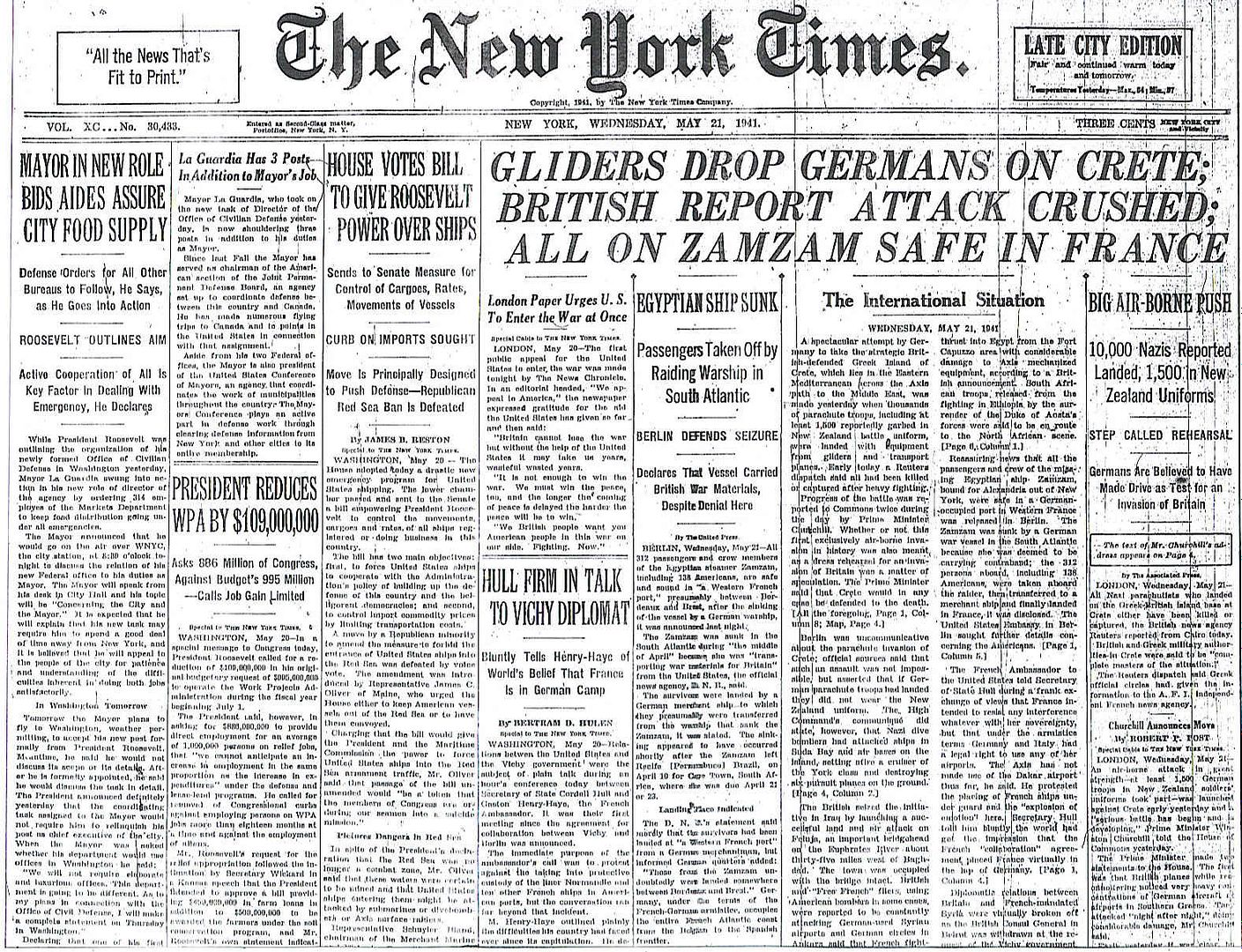
Posted on 05/21/2011 4:52:50 AM PDT by Homer_J_Simpson

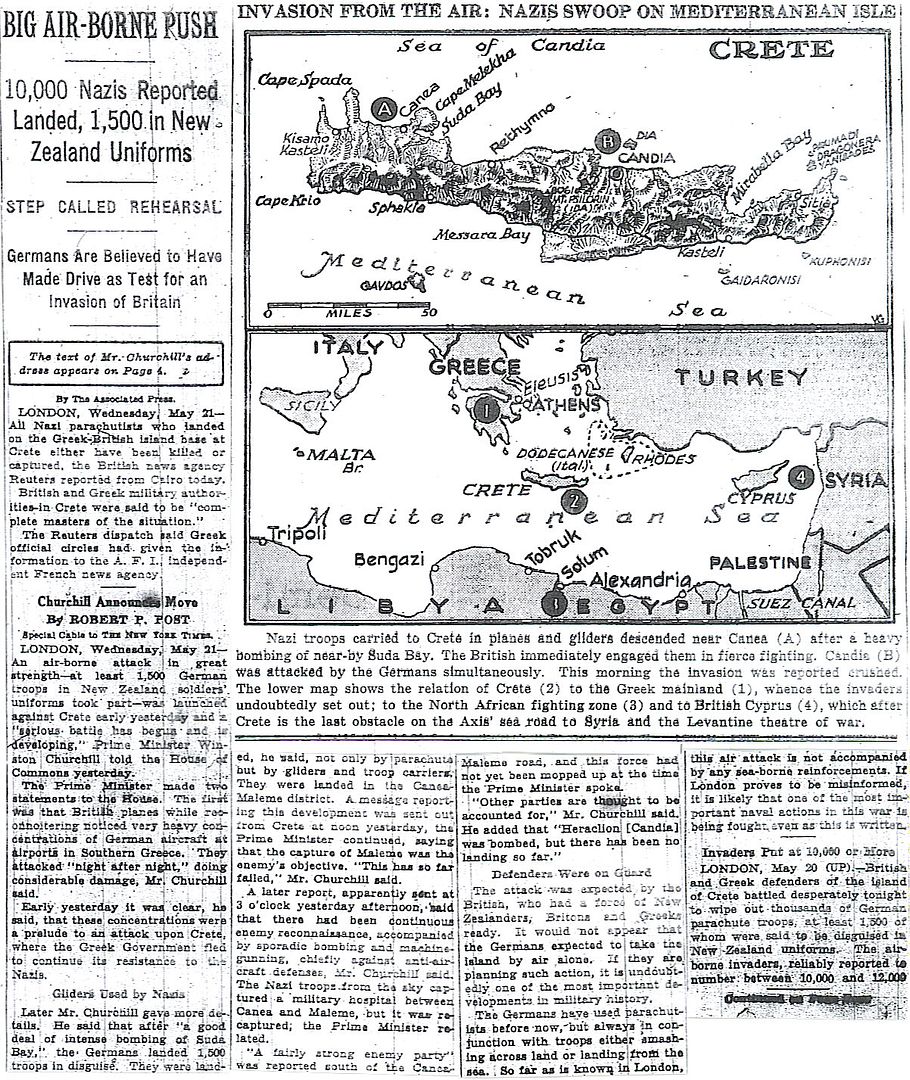

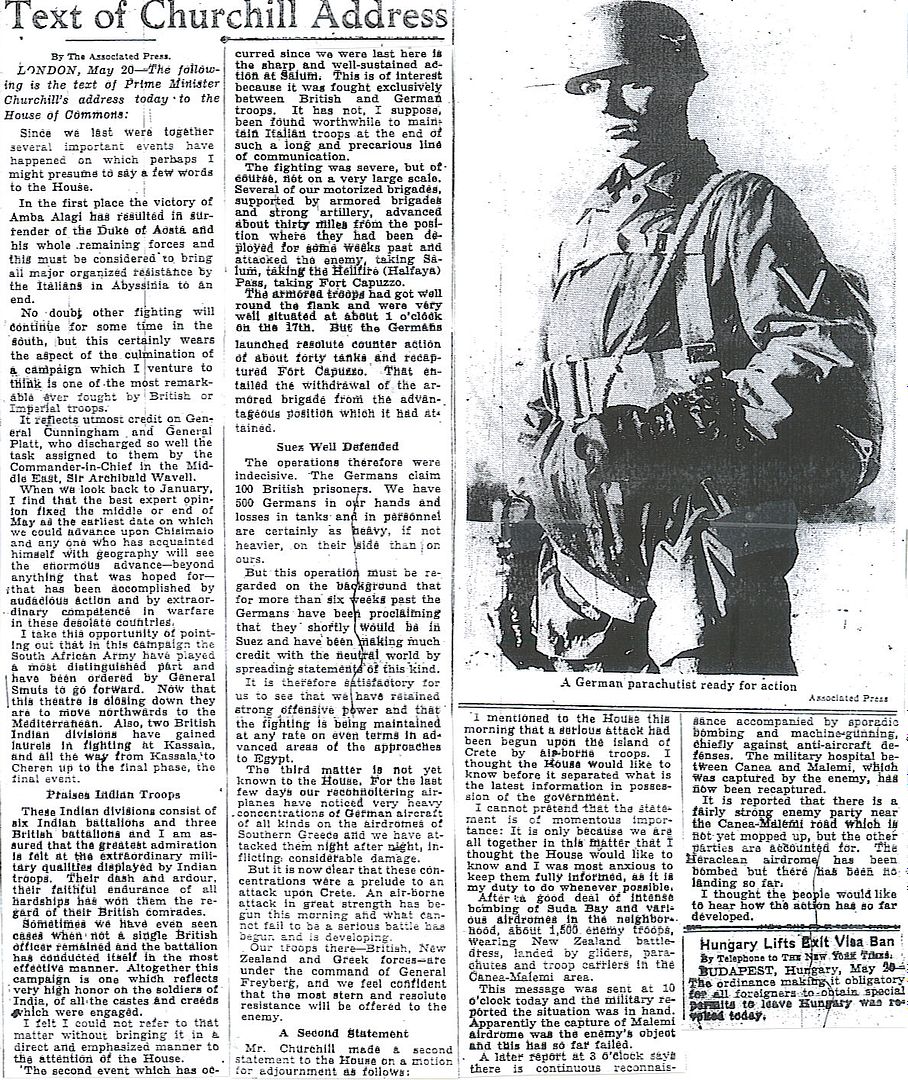
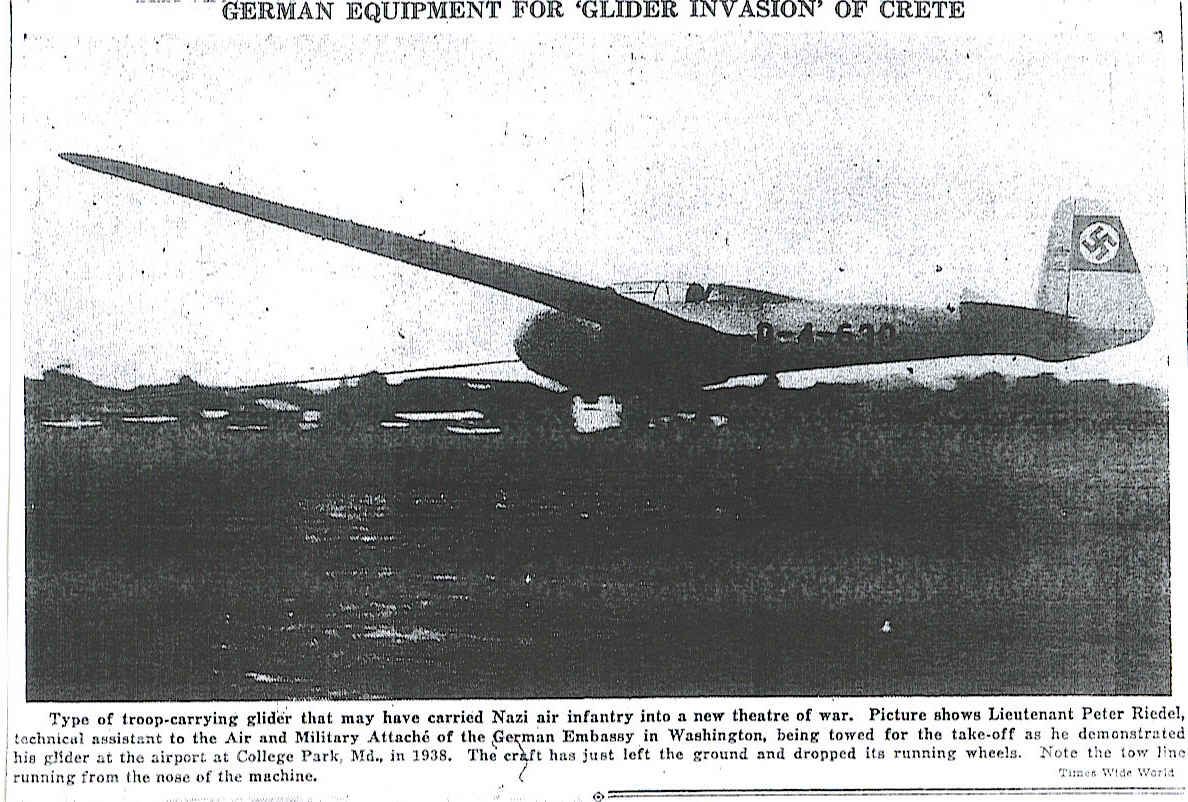

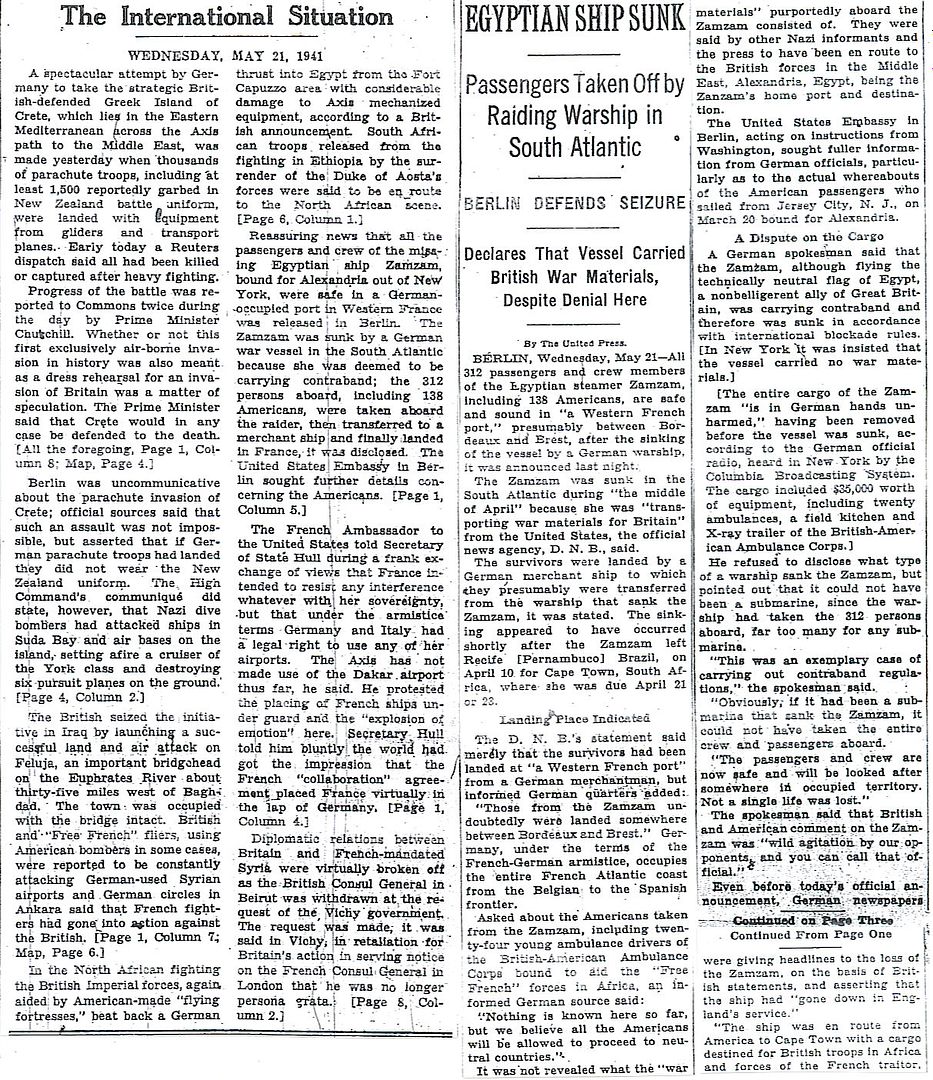
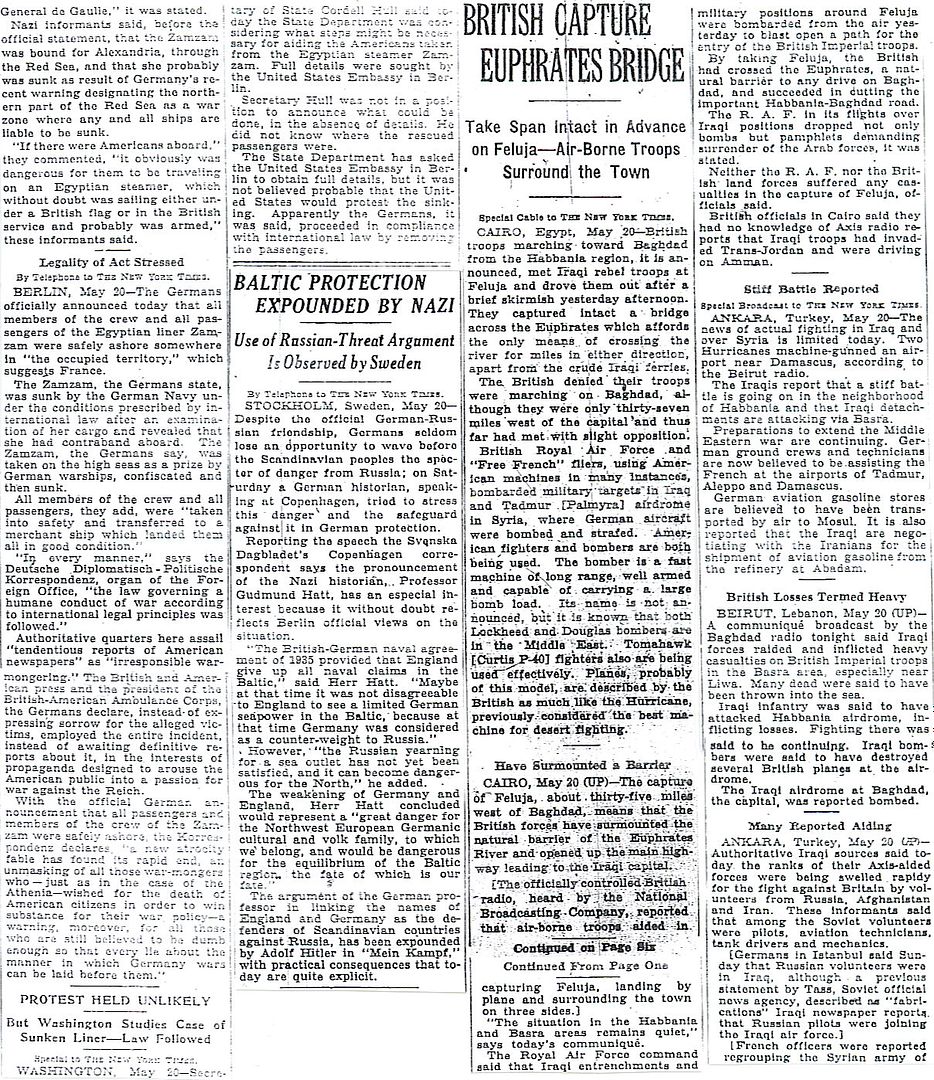

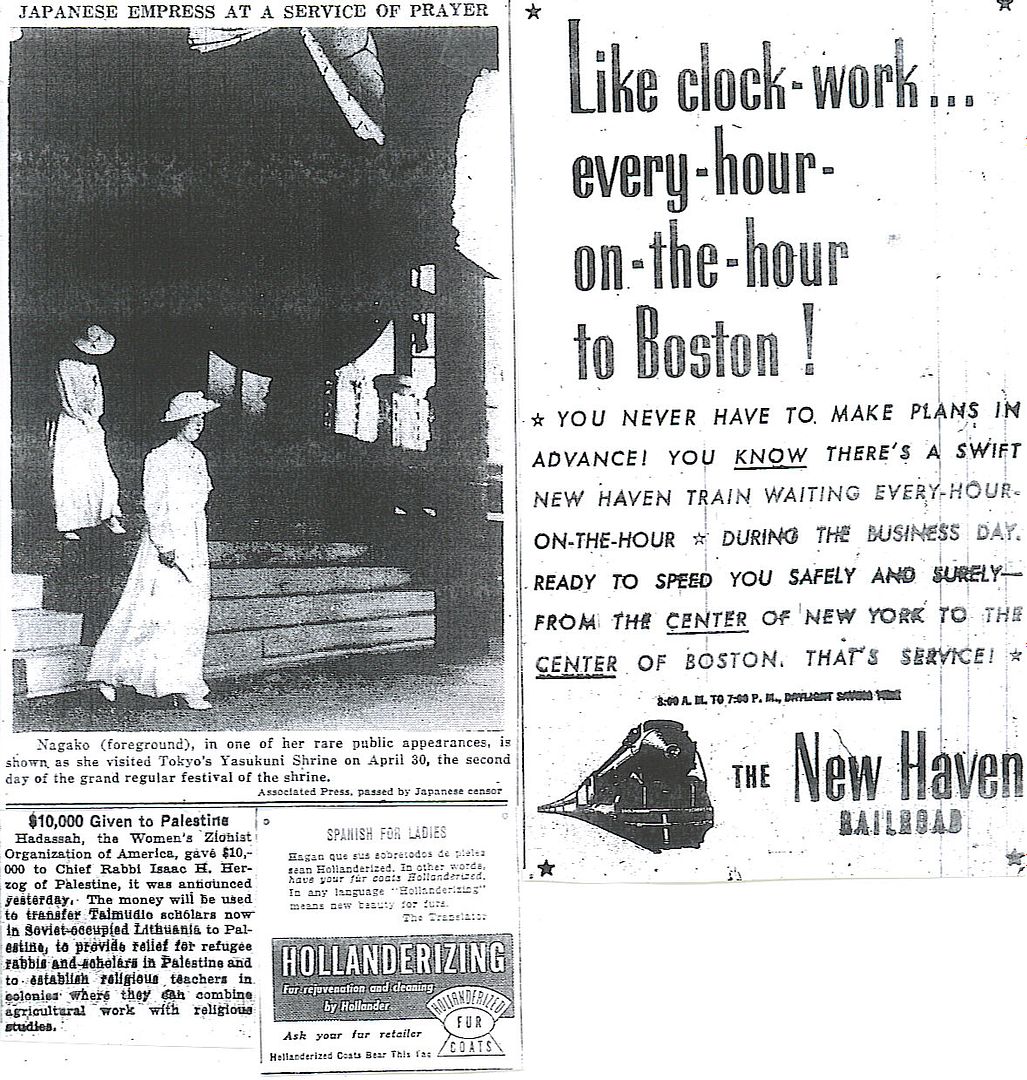
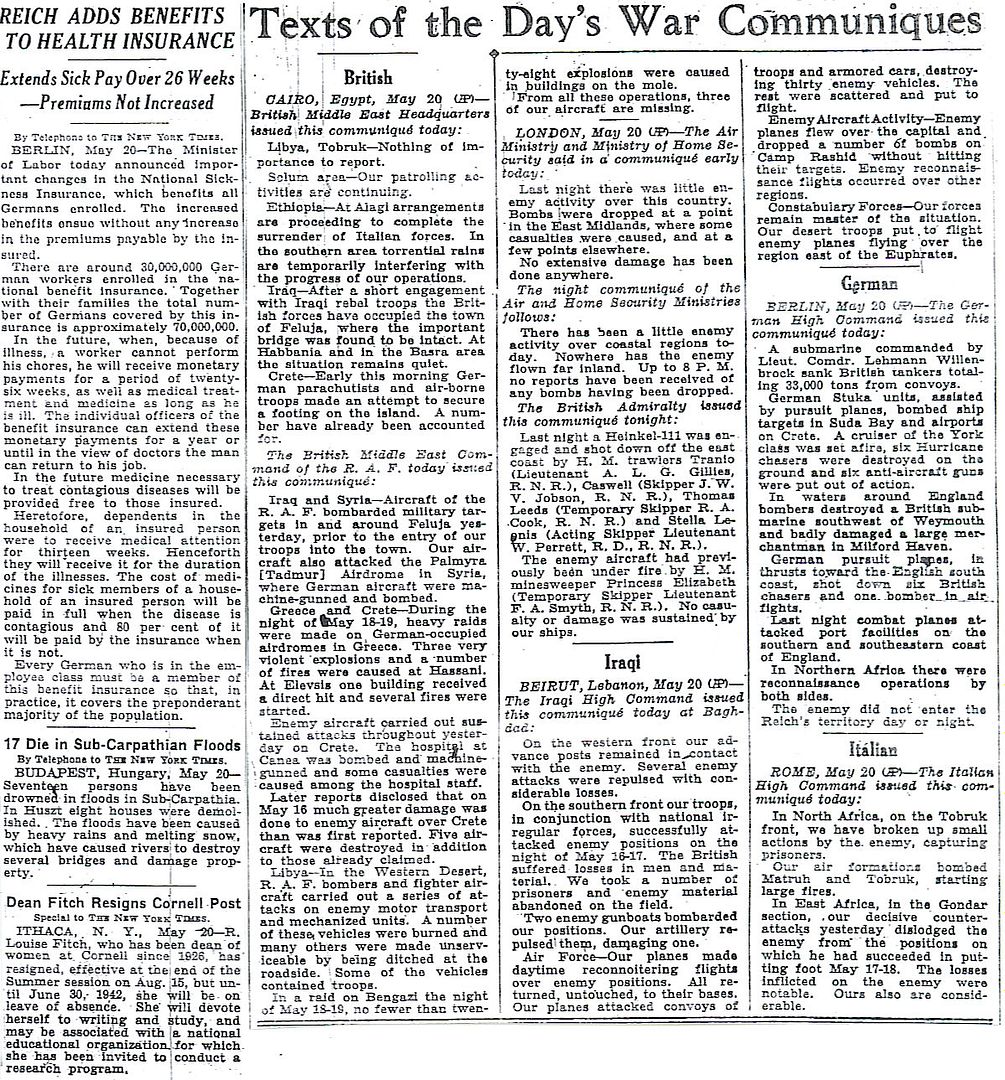
Big Air-Borne Push – 2-3
Germany is Vague on Drive in Crete – 3
Text of Churchill Address – 4
German Equipment for ‘Glider Invasion’ of Crete (photo) – 5
An Invasion Rehearsal? – 6
Lane, In Budapest, En Route to U.S. – 6
The International Situation – 7
Egyptian Ship Sunk – 7-8
Baltic Protection Expounded by Nazi – 8
British Capture Euphrates Bridge – 8-9
Big German Force Near Soviet Line – 9
£23,300,000 Opens War Weapons Week – 9
Cuban Envoy Hails Americas’ Liberty – 9
Japanese Empress at a Service of Prayer (photo) – 10
Reich Adds Benefits to Health Insurance – 11
http://www.onwar.com/chrono/1941/may41/f21may41.htm
Roosevelt bellicose over sunken ship
Wednesday, May 21, 1941 www.onwar.com
In Washington... Roosevelt describes the sinking of the Robin Moor the day before as “an act of intimidation” to which “we do not propose to yield.”
In the North Atlantic... British reconnaissance aircraft find the German ships Bismark and Prinz Eugen near Bergen. Later in the day the battleship Prince of Wales and the battlecruiser Hood put to sea from Scapa Flow.
In the Mediterranean... On Crete, the Germans consolidate their hold on Maleme. The first troops of the 5th Mountain Division are flown in. During the night the nearby New Zealand forces counterattack and although they have some success they do not penetrate to the airfield. Also during the night, a German convoy attempting to reach the island is intercepted and turned back without loss by a force of cruisers and destroyers. Meanwhile, the carriers Ark Royal and Furious fly off a cargo of 48 Hurricanes to Malta. In the air fighting since January the Germans have lost 62 aircraft and the Italians 15. The British losses in the air have been 32 machines, as well as an equal number destroyed on the ground. A British destroyer is lost to air attack.
http://homepage.ntlworld.com/andrew.etherington/month/thismonth/21.htm
May 21st, 1941
FRANCE: The Germans request that foreign diplomatic agents in Paris evacuate by June 10.
GERMANY:
U-170 laid down.
U-129, U-402 commissioned.
U-156, U-208 launched. (Dave Shirlaw)
GREECE: CRETE: Student decides to deploy all his remaining forces on the island to seize the airfield at Maleme. The wounded General Meindl is succeeded by Colonel Ramcke, who parachutes in today. At dawn Dr. Neumann, acting commander of I. Battalion Sturm regiment, overseas the storming of Hill 107 that dominate Maleme airfield. By 17:00 Maleme is in German hands and several Ju52s had already landed.
The first companies of the German 100th Mountain Infantry Regiment land at Maleme.
At 1800 on May 21st, Ramcke and 500 Fallschirmjäger reinforcements drop into Crete west of the Tavronitis and east of the airfield at Maleme. Upon landing, Ramcke is briefed on the current situation by Oberleutnant Göttsche, the Nachrichtenoffizier of Luftlande Sturmregiment Stab.
Oberst Meindl had been evacuated, many of the Sturm Regiment officers had been killed or wounded in the fighting. However, there was some good news. Maleme airfield had been captured but allied artillery spotters were dug in on the slopes of Hill 107, which overlooked the airfield and were directing fire on to the airstrip. One assault group was about to launch an attack on Hill 107 and the first of the JU52’s carrying the badly needed Mountain Troops had just landed, although under heavy artillery fire. Once grouped, the Gebirgsjäger were ordered to head south and outflank the enemy positions. Two battle groups of Fallschirmjäger were ordered eastwards to try and break through to Group Centre at Chania.
In the evening of the 21st, Ramcke was informed that the assault on Hill 107 had failed. Hours later he was informed that the seaborne armada had been destroyed whilst en-route to Crete.
In the opening stages of the attack on Crete, cruiser minelayer HMS Abdiel lays mines off the west coast of Greece, which sink the Italian destroyer ‘Mirabello’ and two transports.
In the morning destroyer HMS Juno is sunk and cruiser HMS Ajax slightly damaged as they withdraw southwest of Crete. Juno is bombed by German aircraft and sunk at 34 35N, 26 34E. There are 97 survivors rescued by HMS Nubian, HMS KANDAHAR and HMS Kingston. (Alex Gordon)(108) Later that evening HMS Ajax, with HMS Dido, HMS Orion and four destroyers savage a German troop convoy of small craft. More such vessels are sunk over the next few days off the north coast.
In the opening stages of the attack on Crete, cruiser minelayer HMS Abdiel lays mines off the west coast of Greece, which sink the Italian destroyer ‘Mirabello’ and two transports. In the morning destroyer HMS Juno is sunk and cruiser HMS Ajax slightly damaged as they withdraw SW of Crete. Later that evening HMS Ajax, with Dido, Orion and four destroyers savage a German troop convoy of small craft. More such vessels are sunk over the next few days off the north coast. (Dave Shirlaw)
MEDITERRANEAN SEA: HMS Furious and HMS Ark Royal fly off 48 Hurricanes to Malta.
PALESTINE: Wavell orders General Maitland Wilson to prepare plans for invasion of Syria. Wilson will have 7 Aust Div (less one brigade), 5 Indian Brigade and 5,000 Free French. Altogether the initial invasion force will be about 34,000 – 18,000 Australians, 9,000 British, 5,000 Free French and 2,000 Indians. The Vichy commander General Dentz has about 35,000 troops comprising 20 battalions of French-led Senegalese, Algerian and Moroccan troops, plus four battalions of 6th French Foreign Legion Regiment. These 3,000 mixed French, Spanish, Germans, Russians and Irish will prove the best troops on the Vichy side and will frequently be shifted to threatened sectors. Crucially, General Dentz has 90 first-line tanks, whereas the British have none, and only limited Australian light armour. The allies have 70 aircraft versus 100 French aircraft. The French Dewoitine S520 will prove the equal of Commonwealth Hurricanes and Tomahawks. Both sides will make use of naval bombardment on the coastal axis, however the allies have a stronger naval force. Vice-Admiral King RN has three cruisers, six destroyers and a landing ship versus several French destroyers. (Michael Alexander)
A French defector, Colonel Collet, informs the Free French that the Vichy French army in Syria would not oppose arrival of German air units and would fight the Allies. They had already assumed defensive positions along the border.
REPUBLIC OF SOUTH AFRICA: Cape Town: Jan Smuts, South Africa’s Prime Minister and war overlord, was today given a present for his 71st birthday: a field marshal’s baton.
“Your promotion to the highest military rank will be warmly welcomed,” King George cabled, “not only for your great and devoted services, but as a leader of a people whose fighting men have been playing a most brilliant part in the victorious campaign in East Africa.”
The esteem in which Smuts is now held in Britain is not without its ironies; in the Boer War he had been the leader of a Boer kommando group against the British forces. Later, after the peace negotiations, he was widely regarded as the architect of South Africa’s Dominion status.
COMMONWEALTH OF THE PHILIPPINES: Grunert recommends to Marshall that a conference be held at the Philippine Department Headquarters at Fort McKinley to develop plans for defence of the islands, this to be paid for from the $52 million in impounded “Sugar Excise Funds”. This was either ignored or not approved.
Marshall informs Stimson that MacArthur would command when the Philippine forces were mobilized. (Marc Small)
CANADA: Minesweeper HMCS Drummondville launched Montreal. (Dave Shirlaw)
U.S.A.: Washington: Roosevelt promises six additional small aircraft carriers to Churchill. The first three should be available in three or four months.
(Jack McKillop adds): These were six Bobue/Prince William Class ships that the US Navy identified as BAVG’s, i.e., British Aircraft Escort Vessels. They were:
BAVG-1: Ex SS Mormacland built by the Sun Shipbuilding Co and converted at the Newport News Shipbuilding and Dry Dock Co, Virginia. Transferred to the Royal Navy on 17 Nov 41, named HMS Archer, and returned to US Navy on 9 Jan 46. Her name was struck from the Navy List on 26 Feb 46 and she was sold.
BAVG-2: Ex SS Rio Hudson built by and converted by Bethlehem Steel on Staten Island, New York. Transferred to the Royal Navy on 2 Mar 42 and named HMS Avenger. The ship was torpedoed on 15 Nov 42 and sunk at Gibraltar. Her name was struck from the Navy List on 16 May 44.
BAVG-3: Ex SS Rio Parana built by and converted at Atlantic Basin Iron Works. Transferred to Roayl Navy on 5 May 42; returned to US Navy 9 Apr 45 and loaned to France the same day as Dixmude. Returned to US Navy 10 Jun 66 and sunk as a target.
BAVG-4: Ex SS Rio de la Plata built by Sun Shipbuilding and converted at Newport News Shipbuilding and Dry Dock Co. Transferred to Royal Navy Sep 41 and named HMS Charger. Returned to US Navy 4 Oct 41, reclassified AVG-30 and commissioned as USS Charger, 3 Mar 42. She served mainly as a training ship on the East Coast until struck from the Navy List in Mar 46.
BAVG-5: Ex SS Rio de Janeiro built by and converted at Tietjen and Lang Dry Dock Co. Transferred to the Royal Navy and named HMS Dasher. She was destroyed on 27 Mar 43 by an internal explosion and her name was struck from the Navy List on 2 Jun 45.
BAVG-6: Bogue Class ship built by Willamette Iron. Transferred to the Royal Navy 31 Jan 43 and named HMS Tracker. Returned to US Navy 29 Nov 45 and her name was struck from the Navy List on 21 Jan 46.
The ninth Lake-class US Coast Guard Cutter, USCGC Shoshone (CGC-50), is transferred to the Royal Navy as HMS Languard.
The USN begins work on a liquid-fuelled assisted takeoff unit for use on patrol planes which became known as jet assisted takeoff (JATO).
(Jack McKillop)
ATLANTIC OCEAN: German U-boat, U-69 (Jost Metzler) stops and sinks the US merchant freighter SS Robin Moore with a torpedo and gunfire 700 miles west of Liberia in Africa. The Robin Moore was enroute to South Africa and Mozambique and U.S. flags are prominently painted on her sides. All 46 people aboard, including eight passengers, are uninjured and board lifeboats. President Roosevelt describes this as “an act of intimidation” to which “we do not propose to yield”. (Jack McKillop)
A few hours later U-69 spotted British freighter TEWKESBURY (Master Captain Pryse on a passage from the River Plate to the U.K.), and after 4 hours of getting into position, fired one torpedo that hit the ship. TEWKESBURY was abandoned as she was sinking, and when the two boats were clear, U-69 fire 25 HE shells into her superstructure and hull, but she would not sink fast enough, so U-69 turned stern on and fired a torpedo from her stern tube. TEWKESBURY broke in half and sank 7 minutes later. However TEWKESBURY managed to broadcast SOS and her position several times, thereby alerting the Admiralty that there was a U-boat further west and south than any U-boat had previously ventured. U-69 continued on her secret mission to mine Takoradi and Lagos, but with her position compromised, she radioed back in plain text (she’d passed over her ENIGMA machine and code books earlier because of the risk of capture) to Doenitz that she had sunk ROBIN MOOR too. After long lifeboat voyages, in which the two boats from TEWKESBURY got separated, both boats were independently picked up. Captain Pryse’s boat was spotted by (US) EXHIBITOR after five and a half days. Chief Officer Howlett’s boat was spotted by (US) ANTINOUS after thirteen and a half days. All crew of the TEWKESBURY survived. Both boats had to fight off shark attacks, and the attentions of other curious creatures. Howlett eventually received an MBE for his leadership, whilst Bosun Ramirez received a King’s Commendation for Brave Conduct for grappling a shark that mounted the sternsheets of his lifeboat, thereby saving the occupants. (Bernard de Neumann )
U-69 on her long mission, having handed over her confidential books and Enigma coding machine when she refuelled from Egerland on 19 May, encountered US merchantman Robin Moor. Having ordered her to stop and then investigating her manifest and cargo, Metzler (commander of U-69) decided to sink her. The crew and passengers were ordered into the boats, and then U-69 sank her with one torpedo and several rounds of HE. Robin Moor was the first US merchant ship sunk by hostile action in the Second World War. (Sunk in position 6.10N, 25.40W) U-69 then set off again heading eastwards, and in the late afternoon encountered the British merchantman Tewkesbury which was identified as British by her stern-mounted deck-gun and, after sunset, lack of navigation lights. U-69 took almost 4 hours to get into position because of the zigzag course Tewkesbury was steering, and then fired one torpedo from just over 1 km that hit Tewkesbury in number 2 hold. The ship, which got away, and received an acknowledgement, her position and type of attacker, was abandoned but did not sink. After about 15 minutes U-69 began firing HE shells at her from her deck gun hitting the superstructure and causing a fire. Tewkesbury still did not sink. 36 minutes after beginning the shelling U-69 turned stern on and from a range of 625 meters fired one torpedo from her stern tube at the stationary ship. Tewkesbury broke in two and sank quickly with the bow section first in position 5.49N, 24.09W. Her position revealed, and with no coding apparatus, U-69 radioed back to BdU in plain text his reports of the sinkings. One of Robin Moor’s boats was picked up by a British merchantman on 3 June and the other on 8 June by a Brazilian merchantman. One of Tewkesbury’s boats was picked up by US merchantman Exhibitor on 26 May and the other by US merchantman Knoxville City on 2 June. All crew and passengers from both ships survived, but the Chief Engineer of Tewkesbury died from the injuries he sustained a few months later
.
In the evening the German ships BISMARK and Prinz Eugen are sighted in a fjord south of Bergen. two of the Home Fleet’s capital ships, HMS Hood and HMS Prince of Wales (the latter new and still working up), sail from Scapa Flow towards Iceland to support the cruisers on Northern Patrol.
The Elusa was in Convoy HX-126 which had already lost seven ships the day before. Her crew witnessed the explosion of the British Security, which was also carrying gasoline and was sunk with all hands by U-556. U-93 had tried for hours to come into a position from which an attack was possible, and when at last a torpedo was launched it missed the target, a tanker. In a second attack at 0522 two single torpedoes were launched on a freighter and on a tanker, but missed the targets again. However, the torpedo aimed at the freighter hit the Elusa at 0529. Immediately after the tanker was hit, the cargo caught fire, mainly in the rear section of the vessel where the crew quarters were located. According to regulations they had stopped the main engines. Some crewmembers at the rear of the ship did not wait for orders to abandon ship. They immediately lowered the lifeboats and left the vessel, which saved their lives. Amidships some Chinese crewmembers also lowered a lifeboat without orders, and rowed away before the other crewmembers could enter it. Remembering the fate of the British Security, doubtless they wished to waste no time distancing themselves from their explosive cargo. The other crewmembers succeeded in lowering another lifeboat, in which all the remaining crewmembers found a place. The master coolly remained on board the Elusa, throwing the classified documents overboard and succeeding in levelling the vessel, which was listing to starboard. Thirty minutes after the hit a British destroyer arrived, rescued the crewmembers in the three lifeboats and took the master aboard. The destroyer stayed near the burning ship during the night. Soon it became clear that the first engineer was missing (caught by surprise by the fire). Moreover two Chinese, the third cook and a donkeyman drowned when they tried to get into the lifeboats. In the next morning the master, the first mate and the second engineer reboarded the Elusa and they saw how devastating the fire had been, but they also discovered that the boilers of the vessel were still in good shape. But fact was that the vessel was not able to sail under its own power and the distance to the nearest tug was too big, so they left the Elusa who was still afloat (She sank later in 58.30N/38.10W). The 49 survivors were disembarked at Reykjavik on 25 May.
At 0512, the Marconi, dispersed from Convoy OB-322, was hit by one torpedo from U-98 and sank after 33 minutes SSE of Cape Farewell. The ship had been missed by the same U-boat in grid AJ 3455 at 1836 on 20 May. 19 crewmembers and three gunners were lost. The master, 54 crewmembers and one gunner were picked up by USCGC General Greene and landed at St John’s. (Dave Shirlaw)
http://www.kbismarck.com/histoperi.html
21 May 1941 (Wednesday):
0800-0900. The German battle group enters the Korsfjord near Bergen.
1100. Bismarck anchors in the Grimstadfjord. Position 60º 19’ 48” North, 05º 14’ 48” East.
1315. Sighted and photographed by a British Coastal Command Spitfire.
2000. Leaves the Korsfjord together with the Prinz Eugen and the three destroyers.
2340. Course 0º.
http://www.2ndhmsmanchesterassoc.org.uk/1937-42_Cruiser_Page_2.html
21st May 1941 - MANCHESTER and her sister ship BIRMINGHAM detailed to establish a patrol line between Iceland and the Faroe Islands to intercept any possible breakout of the German battleship BISMARCK into the Atlantic.
http://worldwar2daybyday.blogspot.com/
Day 629 May 21, 1941
Crete. At 3 PM, General Student sends in 2 more companies of paratroops who are slaughtered as they land among New Zealand Maori troops. Student then ignores German doctrine not to reinforce failure & sends 40 Ju52 transports to land 650 5th Mountain Division troops on Maleme airfield giving them control of the landing strip. Many of the Junkers are destroyed before they can take off. General Freyberg still holds back his reserves, expecting amphibious landings. The only seaborne activity is a flotilla of 19 fishing boats and 2 small steamers which set out from the island of Milos carrying 2331 German troops and supplies (no tanks). At midnight, 3 Royal Navy cruisers and 4 destroyers intercept sinking 11 small vessels (297 Germans killed, Italian torpedo boat Lira rescues survivors). Italian torpedo boat Lupo attacks the British warships with torpedoes and her 4-inch guns allowing the other boats to scatter (Lupo is hit by 18 6-inch shells but survives).
During the day, Luftwaffe attacks British warships sweeping the coast of Crete. Cruisers HMS Dido, Orion & Ajax and 4 destroyers suffer minor damage in 4 hours of bombing off Canae, where the invasion fleet is expected. 45 miles Southeast of Crete, destroyer HMS Juno is hit by 3 bombs from 5 Italian Cant Z.1007 bombers and sinks in 3 minutes (128 killed, 97 survivors picked up by destroyer HMS Nubian).
Operation Rheinübung. German battleship Bismarck and cruiser Prinz Eugen stop in Grimstadfjord, Norway, to refuel the cruiser. At 1.15 PM, RAF Flying Officer Michael Suckling spots the warships while doing reconnaissance in a Spitfire over Bergen (only 5 miles away). British Admiral Sir John ‘Jack’ Tovey, commander of the British Home Fleet, sends out all available warships (including battleship HMS Prince of Wales and battlecruiser HMS Hood) to patrol the Denmark Strait and the Iceland-Faroes gap. At 7 PM, the German ships head out into the North Sea and overnight RAF bombers attack the empty fjord.
At 5.25 AM 850 miles West of Freetown, Sierra Leone, U-69 sinks neutral American SS Robin Moor (first American merchant ship sunk by a U-boat). All 38 crew and 8 passengers (including 3 women and a child) abandon ship in 4 lifeboats. 35 survivors in 3 lifeboats are picked up on June 2 by a British merchant and landed at Capetown, South Africa. The final boat with 11 survivors is picked up on June 8 by Brazilian SS Ozório after floating 900 miles. US President Roosevelt protests the sinking and demands compensation from Germany but to no avail. At midnight, U-69 sinks British SS Tewkesbury (all 42 hands escape in lifeboats). In the North Atlantic off Greenland, U-93 sinks Dutch tanker Elusa (5 killed, 49 rescued by a British destroyer) and U-98 sinks British SS Marconi (22 dead, 56 picked up by US Coast Guard patrol boat General Greene).
http://www.archive.org/stream/mightyhood007042mbp/mightyhood007042mbp_djvu.txt
THE MIGHTY HOOD
by Ernle Bradford
pg 160
As night fell over the Orkneys, and no further news came
through, Admiral Tovey decided to sail the Hood and the Prince of Wales. With them would go the six destroyers Achates, Antelope, Anthony, Echo, Electra, and Icarus. The force would make for Hvalfiord and refuel. They would hold themselves in readiness for any attempted breakout by the Bismarck and the heavy cruiser.
Midnight May 21, 1941. The clank of cable coming in was followed by a sighing hush as the ship’s bows turned toward the sea and the north.
“What’s the buzz?”
“Hovelford.”
“Not again!”
So many times in her long career she had sailed from this ring of Viking islands. Now, as always, there accompanied her the sad cries of the molliemawks, and the song of the wind over the tangled hills. The islands were dark against the sky, and the boom gates were closing behind Admiral Holland’s force.
Be it wind, be it weet, be it hail, be it sleet,
Our ship must sail the faem. . . .
Two hours before Admiral Holland’s ships sailed from Scapa
Flow, the Bismarck had slipped out from Bergen and sailed for the north. Admiral Lutjens’ ships were complete with fuel, and a feeling of optimism possessed the German sailors. They knew that British air reconnaissance had sighted them in their hideout, but they were not unduly worried. It was unlikely, they felt, that the British would expect them to make a dash for the Denmark Strait from a point so far to the south of Iceland. The weather was coming down thick, and there was a good chance that the British would be unable to get any further news of them during the next day, May 22.
Nothing could have suited Admiral Lutjens better. With any luck, by the time that further reconnaissance planes had got over to discover the empty fiord, he and his two ships would be through the Denmark Strait with all the immensity of the Atlantic in which to operate, and in which to hide.
Friendly reminder:
Those gliders were made in America.
http://www.hmshood.com/history/denmarkstrait/bismarck1.htm
Hood’s Departure
Hood, Prince of Wales and their destroyer escorts, weighed anchor at 2356 hours. They departed Scapa Flow at midnight, 22 May, enroute for Hvalsfjord. They cleared Scapa’s Hoxa Gate at 0050 hours. Shortly thereafter, the destroyers were divided into two divisions- one to screen Hood and the other to screen Prince of Wales. The vessels then commenced zigzagging (for anti-submarine purposes) and assumed a heading of 310°. Sometime that morning, VADM Holland informed his commanders of the gunnery policy he wanted: ‘If the enemy is encountered and concentration of fire required, the policy will be G.I.C. (individual ship control); if ships are spread when enemy is met they are to be prepared to flank mark as described in H.W.C.O. 26’. Due to the implementation of strict radio silence, these orders were never communicated to Suffolk or Norfolk.
http://www.hmshood.com/history/denmarkstrait/bismarck1.htm
Bismarck Leaves Norway
Lütjens’s force had sailed from Bergen during the early evening of 21 May. The poor weather conditions were perfect for an undetected departure. The question remains as to why he did not refuel Bismarck. It is possible that he initially intended to refuel from the tanker Weissenberg in the Arctic. It is also possible that as the hours passed, he felt it wiser to make for the Denmark Strait as quickly as possible, lest they lose the cover of the bad weather. Whatever his reason, it was another decision he would later regret.
I noticed, on page 11, that the Nazis had their own version of 0bamacare.
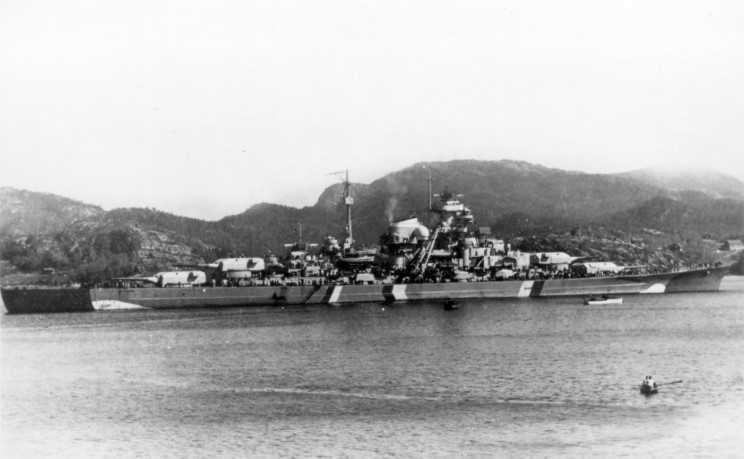
21 May 1941 at about 11:00 A.M. the Bismarck anchored in Grimstadfjord in Norway (the Prinz Eugen and the destroyers went farther north and anchored in the Kalvanes Bay).

Hood sailing from Portsmouth on 11 May 1934. Though frequently away for months at a time, her crews and their families were spared the extended foreign service routinely performed by much of the British Fleet. Other than the war, Hood's longest absence from her home port was the nineteen months she spent in the Mediterranean between June 1937 and January 1939.
Hood emerges from one of the Gatun Locks on her way to the Caribbean. Notice the wind scoops fitted to the scuttles to improve ventilation of the living spaces.
The Hood anchored off Honolulu, June 1924. This photo shows the distinct flare of her hull. designed to lessen the angle at which a shell might strike her side. She is moored with both her bower anchors. their cables joined with a mooring swivel.
Hood docked at Portsmouth in February 1935 for repairs following her collision with the Renown. Her starboard outer propeller was severely damaged and distortion caused to plates and frames on the hull. The quarterdeck suffered an 18·inch indentation and repairs were needed for the inner propeller
More than a scratch: crewmen inspecting the damage to the ship's side caused by the bomb hit of 26 September 1939. The 7-inch belt is pitted and gouged while the edge strips joining the bulge to the top of the 12-inch belt have been ripped away. External damage was quickly repaired but the Hood's condensers were brought to the verge of collapse.
Seasonal fare for the lower deck on Christmas Day 1938, the ship lying at Malta. Daily menus were much less varied. The signatures are presumably those of the owner's messmates.
A gathering on the Hood's forecastle during the Invergordon Mutiny, probably Wednesday 16 September 1931
There will be a fine pic of HMS Hood tomorrow as she sails to meet Bismarck in the Denmark Straight.
Leaving today for Crete to visit my son stationed at NSA Souda Bay. How ironic. I plan to visit the War Memorial on Crete.
twelve days:
http://www.historyofwar.org/Pictures/pictures_crete_02.html
Operation Mercury, the German airborne assault on the island of Crete in May 1941, was the first strategic use of airborne forces in history. The assault began on 20 May, with landings near the island’s key airports, and reinforcements the next day allowed the German forces to capture one end of the runway at Maleme. By 24 May the Germans were being reinforced by air on a huge scale and on 1 June Crete surrendered. This book describes how desperately close the battle had been, and explains how German losses so shocked the Fuhrer that he never again authorised a major airborne operation.
[btw, in case no one has said it today, Hitler was a numbskull]
Disclaimer: Opinions posted on Free Republic are those of the individual posters and do not necessarily represent the opinion of Free Republic or its management. All materials posted herein are protected by copyright law and the exemption for fair use of copyrighted works.